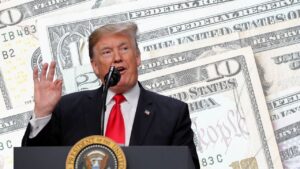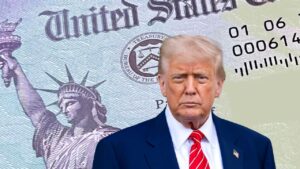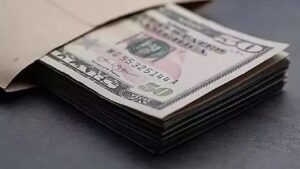Imagine receiving a $2,000 rebate check from the federal government — not as a new stimulus, but as a direct refund funded by import tariffs. That’s the core idea behind a new proposal circulating in Washington that could send tax rebate payments to millions of working families as early as mid-2026.

Known as the American Worker Rebate Act of 2025, the plan would return revenue generated from U.S. trade tariffs directly to households through refundable tax credits — a populist approach that its supporters call a “tariff dividend.”
The measure, introduced by Sen. Josh Hawley (R-Mo.) in July, has sparked both enthusiasm and skepticism across the political spectrum. Proponents tout it as a way to reward American workers and counter inflation. Critics warn it could upend fiscal priorities and depend on an unstable source of funding.

$2,000 Extra in Tax Rebates
The bill would create a new refundable tax credit under the Internal Revenue Code, sending payments of at least $600 per adult and $600 per dependent child. That means a typical family of four could receive $2,400 or more, with higher amounts possible if tariff revenues exceed projections.
The Treasury Department would administer the payments in the same way as past stimulus programs — primarily through direct deposit or mailed checks — making the rebate effectively automatic for most taxpayers.

“It’s time working Americans got a share of the prosperity they help create,” Hawley said in a July press statement. “For too long, trade policy has benefited foreign corporations and Wall Street. This bill uses tariff revenue to reward the people who make and build things here at home.”

Under the plan, payments would phase out gradually for higher-income households, starting at $75,000 for individuals and $150,000 for joint filers — mirroring thresholds used in previous relief programs. Nonresident aliens, estates, trusts, and dependents claimed on another person’s return would be excluded.
Who Would Qualify for the $2,000 Rebate?
Eligibility would depend on income level, filing status, and residency. Here’s what the proposal outlines so far:

| Category | Eligibility Requirements | Estimated Payment |
|---|---|---|
| Individuals | U.S. citizens or permanent residents earning up to $75,000 | $600–$2,000 |
| Married Couples | Joint filers earning up to $150,000 | $1,200–$4,000 |
| Families with Children | +$600 per dependent child | Up to $2,400+ |
| Retirees & Veterans | Eligible if filing 2024 tax return or receiving SSA/VA benefits | $600–$2,000 |
The IRS would issue payments automatically based on 2024 tax filings or existing benefit databases, ensuring low-income and non-filing households are included through the Treasury’s public information campaign.
Where the Money Would Come From?
At the heart of the plan is a single, bold funding source: federal tariff revenues.
The U.S. currently collects tariffs — taxes on imported goods — on items ranging from electronics to steel. In 2024, those tariffs generated approximately $195 billion, according to Treasury data.
The Hawley proposal projects that under the Trump administration’s expanded tariff policy, annual collections could rise to between $200 billion and $300 billion, enough to finance rebates without adding to the federal deficit.
“This is a pay-as-you-go plan,” said Sen. Hawley in a recent Fox News interview. “We’re not printing money. We’re redistributing funds already being collected from foreign imports — directly to American families.”
However, economists caution that tariff revenues are volatile and can be offset by lower trade volumes, making them an unstable foundation for ongoing payments.
“Tariffs can raise significant revenue, but they also raise consumer prices,” said Dr. Elaine Carter, a trade policy expert at the Peterson Institute for International Economics. “That means families may pay more at the checkout line — even as they receive a rebate.”
The Economic and Political Debate
The proposal’s appeal lies in its populist framing: it connects trade protectionism with household relief, portraying tariffs not as penalties, but as a source of national income redistribution.
Supporters within the Trump administration see the plan as a logical extension of “America First economics,” using tariff revenue to deliver tangible benefits to citizens rather than corporations.
But opponents warn of fiscal and constitutional pitfalls. The Supreme Court is currently reviewing the legality of several of the tariff measures underpinning the program, raising concerns that the funding base could collapse if the court rules against the administration.
“You can’t build permanent rebates on temporary tariffs,” said Janet Yellen, former Treasury Secretary, during a recent appearance on CNN. “This isn’t a sustainable fiscal model — it’s a short-term political message dressed up as tax policy.”
Others argue that any surplus tariff revenue would be better used to reduce the national debt or invest in infrastructure, rather than distributed as direct payments.
The American Worker Rebate Act of 2025: What’s in the Bill
Filed as S.2475 in the 119th Congress, the American Worker Rebate Act of 2025 amends the Internal Revenue Code to create an entirely new section for tariff-funded tax refunds.
Key provisions include:
- Minimum Payment: $600 per adult and dependent
- Refundable Credit: Fully refundable, meaning even non-taxpayers can receive it
- Phase-Out Range: Begins at $75,000 (individuals) / $150,000 (joint filers)
- Delivery: Direct deposit or mailed check, similar to 2020–2021 stimulus payments
- Public Awareness Campaign: Treasury will notify eligible households not required to file taxes
- Exclusive Financing: All payments must come from tariff revenue — no borrowing or new taxes
The bill also establishes an annual Tariff Revenue Report, requiring the Treasury to disclose collections, disbursements, and the average rebate per taxpayer.
“Transparency is critical,” said Sen. Hawley. “Americans deserve to know how much tariff revenue their country collects — and how it’s being returned to them.”
When Could Families Receive Payments?
If the bill passes Congress by early 2026 and tariff collections remain steady, the first rebate payments could arrive mid-2026, likely between June and August, according to early Treasury estimates.
Distribution would likely mirror the IRS Economic Impact Payment (EIP) model used during the COVID-19 pandemic, issuing payments in waves based on income, filing date, and benefit status.
Expected timeline:
- Spring 2026: Final budget approval and Treasury setup
- Summer 2026: Initial direct deposits begin
- Fall 2026: Paper checks and follow-up deposits issued
Challenges Ahead: Legislative and Legal Hurdles
Passing the bill won’t be easy. Even among Republicans, opinions diverge on whether rebate programs risk expanding federal spending culture.
House conservatives have expressed concern that the measure resembles previous stimulus efforts that “blur fiscal discipline.” Meanwhile, some Democrats say they could support it — but only if paired with consumer protections against higher retail prices caused by tariffs.
Adding further uncertainty, the Supreme Court case reviewing the constitutionality of unilateral tariff actions by the executive branch could strip away the proposal’s funding base altogether if tariffs are limited or rescinded.
“The legal framework is as critical as the fiscal math,” said Dr. Aaron Kaplan, professor of public policy at Columbia University. “You can’t rebate money that the court may rule the government isn’t entitled to collect.”
Public Reaction and Political Calculus
Public opinion polling shows broad support for direct economic relief, even when tied to controversial revenue sources. A YouGov survey in October 2025 found that 62% of Americans favor the idea of distributing tariff revenue as household rebates, while 28% oppose it and 10% remain unsure.
For many households still recovering from high inflation, the idea of a direct check — regardless of origin — resonates more powerfully than abstract fiscal debates.
“Whether it’s called a rebate or a dividend, it’s help,” said Darlene McCarthy, a retail worker from Ohio who received previous stimulus checks. “Groceries are expensive. Rent is up. If there’s money collected in our name, why shouldn’t we get some of it back?”
FAQ: The $2,000 Tariff-Funded Tax Rebate Proposal
What is the American Worker Rebate Act of 2025?
A bill that would send refundable tax credits of at least $600 per adult and child, funded entirely by U.S. tariff revenues.
Who would qualify?
Low- and middle-income taxpayers, Social Security and VA recipients, and families earning under $150,000 jointly or $75,000 individually.
When would payments start?
If enacted, the Treasury estimates the first checks could arrive by mid-2026.
Do I need to apply?
No. Payments would be issued automatically based on 2024 tax filings or existing benefit records.
Are the rebates taxable?
No. The payments would be non-taxable and would not affect eligibility for programs like SNAP, Medicaid, or SSI.
What happens if tariff revenues fall short?
The law requires the Treasury to scale payments proportionally rather than borrow to cover deficits.
Could the Supreme Court ruling affect the plan?
Yes. If the Court limits or overturns certain tariffs, it could eliminate the program’s funding source.
A New Form of Populist Economics
Whether or not it becomes law, the American Worker Rebate Act reflects a broader trend in American economic policy: turning trade and tax tools into vehicles for direct relief.
It’s a populist approach that connects national revenue to household benefit — bypassing traditional government programs and offering visible, tangible results.
Still, the debate remains deeply divided between those who see it as empowerment for working families and those who view it as short-term populism with long-term risks.
“It’s a race between economics and politics,” said Dr. Kaplan. “If the funding holds and the public stays supportive, it could redefine how we think about tariffs and tax relief. If not, it will be remembered as a headline — not a policy.”

